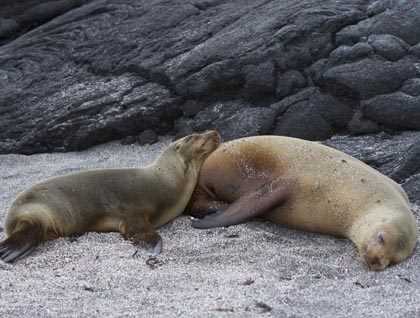The previous night we had our longest navigation of the week, sailing all night long to get to a point located in the western region of the archipelago. This time of the year this group of oceanic islands is bathed by cold, nutrient-rich waters than brings a lot of productivity to Galápagos. This area is also one of the best places to look for whales and other big marine animals.
Our first morning activity was on board the National Geographic Islander. We had an optional wake up call for those eager nature lovers, and we invited our dear guests to our outer decks and immediately had our well-deserved first sightings: Galápagos first seal, Pacific Ocean sunfish, and our big prize, a blue whale, which are rare visitors to these waters.
We continued our navigation to our final destination and by 9:00 a.m. we were crossing the equatorial line for the second time in the week, and as soon as we dropped anchor we went out for a Zodiac ride. The geology at this point is very impressive for its lava dikes formations, lava bombs, tuff cones and some walls that reach about 500 hundred feet above sea level.
During our Zodiac ride we saw Galápagos penguins, Galápagos flightless cormorants, Pacific green sea turtles, sea lions, boobies, pelicans, noddy terns and many other inserting sightings as well. Before our morning schedule was over we even had a chance for snorkeling with the same animals we spotted during our Zodiac ride.
For the afternoon we disembarked at Punta Espinoza, in Fernandina Island, home for a couple of thousand marine iguanas. The tide was very low and it was amazing to see lots of these odd looking sea creatures coming back home from foraging at sea.
As we continued we also spotted a small colony of Galápagos flightless cormorants nesting right inside our trail. This was such a nice moment to enjoy and analyze the morphology of this endemic flightless sea bird at close up.
This time of the year we also have lots of baby marine iguanas along the coast line. They are an easy prey for blue herons, hawks, and snakes, and that is the reason they live very close to fissures to hide when they are attacked by predators.
We had such an extraordinary day in the western part of this isolated oceanic archipelago.







